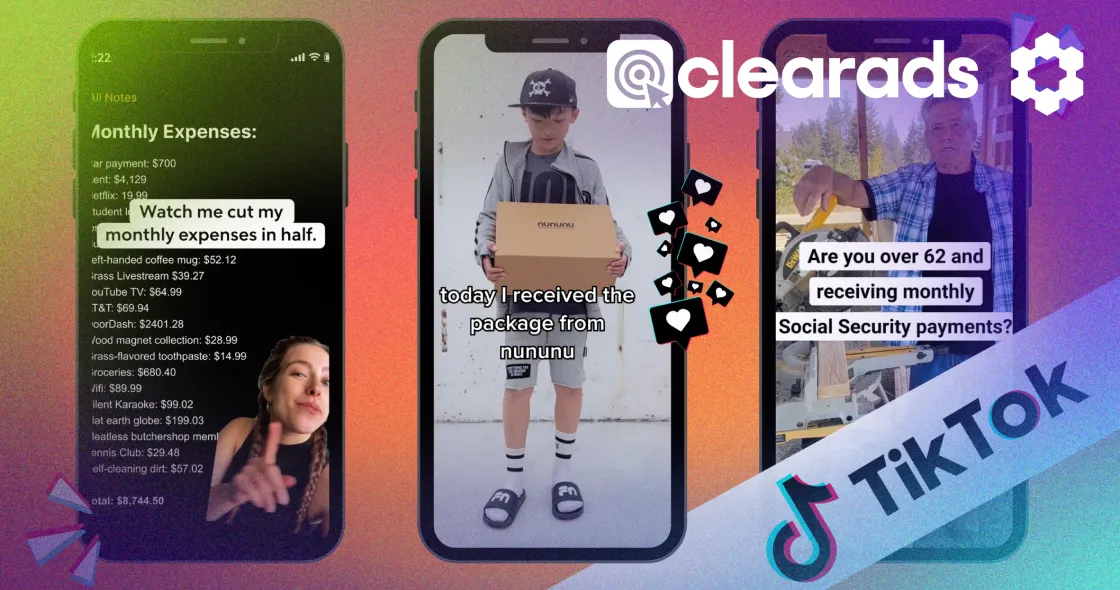We’re learning that TikTok’s influence stretches well beyond mere entertainment. TikTok is reshaping online shopping, from viral organic posts and influencer marketing to advertising solutions and TikTok Shop.
While a lot of the recent hype has been surrounding TikTok Shop (for good reason!), a lot of ecommerce entrepreneurs don’t realize that TikTok actually has an “older sister” advertising solution – one that has been around for longer, has better support resources, and can still be a powerful lever for your business.
Before we dive into the nitty-gritty of TikTok Ads, let’s talk about the pros and cons of TikTok Ads vs. TikTok Shop, and help you understand which is better for you.
Which Is More Effective? TikTok Shop vs. Tiktok Ads

Both TikTok Shop and TikTok Ads have their own set of benefits and setbacks concerning suitability and effectiveness. Let’s discuss them!
What Is TikTok Shop?
It’s essentially affiliate marketing with micro-influencers activated to be the affiliates. Creators need at least 5,000 followers to be eligible to sell products through this platform.
So, TikTok Shop tends to be popular among this micro-influencer set who have some audience, but don’t quite have enough influence to command brand sponsorships at scale (this is when they get paid a set amount upfront per post).
Many small businesses and Amazon sellers are drawn to this growth path because the affiliate commission makes it easy to get started – the creators simply take a percentage of the sales generated, so there’s little downside other than time investment.
TikTok Shop Pros/Cons
Pros:
- Minimal Upfront Investment – As mentioned above, other than time investment, no marketing dollars are required to get started since each creator receives a set commission rate negotiated upon the start.
- Subsidized Sales – TikTok is pushing this product to compete with major ecommerce players, which means they heavily push coupons to get consumers to convert on the platform. The good news is TikTok eats that discount, and you get paid the full retail price listed. And as we all know, promotions can do wonders for driving topline unit sales, so it’s a win-win.
- Cheap Impressions – As far as a brand presence on the platform, activating an army of micro-influencers to talk about your brand without any upfront cost is a huge win. Similar to the above, because TikTok is trying to push this product, TikTok Shop posts seem to get quite a lot of distribution on people’s For Your Page (FYP) these days.
Cons:
- Uncertain Results – It’s extremely competitive with creators having a whole marketplace of products to promote. Signing up for TikTok Shop alone will do nothing, you need to get others signed up to post about your products. Because you’re relying on recruitment efforts, you must find a way to message as many creators as possible and get them to sign up with you. Even then, sales will depend on the quality of the content (how well it converts), the reach of the content (how many people see the post), and the number of influencers signed up (multiplication of the prior factors).
- Buggy Interfaces – Because it’s such a new tool for TikTok and the wave of businesses and creators rushing to join, the most common complaint about TikTok Shop is how buggy it is. Messages won’t load, Shop accounts will get flagged for violations and potential deactivation, product descriptions won’t update, and the worst part is that it’s impossible to reach someone at TikTok to help you resolve these things. You thought Amazon support was bad? Hold my beer.
- No Control Over Brand Messaging – While we do consider it a best practice to create a deck about your messaging (who it’s for, what it does, how to talk about the product, how not to talk about the product, etc.) and we always send it to the creators we work with, it’s never a guarantee that they’ll read it, much less follow it. So if you’re precious about how your brand comes across, who represents it, and how it’s talked about, it’s hard to control it completely, as is the nature of social media.
The bottom line: TikTok Shop is the better option for you if you want to be on TikTok, but don’t have the budget to invest in the channel and are willing to put in the time for additional sales.
What Are TikTok Ads?
These are like any other media platform where you pay on a CPM (cost per thousand impressions) basis and control the budgets, targeting, creative, and click-through destination.
The ads appear in the FYP alongside organic posts, and many consumers (especially older ones, who do exist on TikTok!) can’t distinguish between the two, so we can mimic virality.
How can Amazon sellers take advantage of this? Carbon6 has already mentioned that TikTok values Amazon sellers, but did you know that Amazon also values TikTok traffic?
We’ve tested across brands and have seen Amazon’s organic ranking algorithm favor brands that bring TikTok traffic to the marketplace.
TikTok Ads Pros/Cons
Pros:
- Direct the Traffic – With this tool, you can drive TikTok clicks to an existing sales channel (Amazon, Shopify, Magento, etc.) where they will automatically flow into your existing operations and processes. TikTok Shop runs its orders and payments through the app and tool, so you’d need to sync up order fulfillment processes from there.
- Control & Learnings – With this approach, we not only have complete control of where the traffic goes, but we also have control of the message, the number of impressions/clicks, and who we reach. Not only does this help us drive greater efficiency, but it also helps us understand our target audience – What age range do we get the most conversions from? How do we talk to them about the problem we’re solving? What features do they care about? We can uncover insights like these, which we can apply to things like listing images and even new product development.
Cons:
- Higher Investment – While this strategy can guarantee impressions unlike TikTok Shop, you do need to pay to play. Median CPMs are still lower on TikTok vs. Meta thanks to the average amount of time spent per user being so much higher, but it’s still a budget nonetheless. And with any demand-generating channel, it takes time and rounds of iterative testing to find the pockets of audiences and the type of creative that works.
- High Barrier to Entry – Because we own the end-to-end process with this tool, we build a converting landing page, set up the ad account with tracking, create UGC video content, and conduct media buying. Many businesses don’t have the time or expertise to know how to tackle the channel. That’s when agencies like Clear Ads come in since we cover this scope for clients, from soup to nuts.
The bottom line: TikTok Ads is the better option for you if you want to guarantee presence on the channel and have the budget to support it. It can also be a great lever to support growth on your DTC site and Amazon organic rankings.
Best Practices for TikTok Ads

Okay, let’s say you want to test TikTok Ads. Go you! Let’s start with the basics.
1. Create engaging video content that resonates with the target audience
We start here because it typically takes the longest and drives 60%+ of the performance. You can either pay an influencer to make and post the video so you can run ad dollars to it (this is called Spark Ads) or you can commission your own using UGC creators. If you go with the latter, make sure you follow this formula:
- A Catchy Hook – bonus points for multiple versions to test
- Compelling Value Props – keep the base video fast-paced while delivering value
- A Strong CTA – it’s important to make this more natural so it doesn’t break from the organic content too much. (e.g. less “Buy now!” and more “Check it out, and thank me later.”)
2. Set up your ad account, landing page, and pixels
We recommend driving the traffic to a landing page, even if the purchase happens on Amazon you can place a conversion pixel on a down-funnel action that will help feed data back to the TikTok algorithm about who’s interested in your product. Furthermore, we’ve learned through our testing that it helps to increase conversion rate vs. driving users straight to your listing.
3. Research your audience targeting options
If you’ve advertised on Meta, the best way to describe TikTok’s targeting is what Meta had 5-10 years ago. Meta has more or less turned into a black box, with broad targeting usually outperforming any interest targeting. TikTok has targeting options ranging from pre-built Interest targeting, pre-built Purchase Intent targeting, hashtag engagement, and more. Once you create your Ad account, you’ll have full access to browse all the available audience segments for testing.
4. Go live!
When launching TikTok Ads, we recommend optimizing to the conversion event that’s as far down the funnel as possible (e.g. if you’re driving to your DTC website, optimize to Purchase) and test as many dimensions (audiences and creative messages) as possible without muddying your read on the tests.
When people say they “want to be on TikTok,” there are several ways to do that based on your goals and resources. Being clear on your strategy upfront will ensure optimal results and maximum impact.
Elevating Your Ecommerce Game: TikTok Shop vs. TikTok Ads
TikTok’s influence on online shopping goes beyond mere entertainment, reshaping the landscape with viral organic posts, influencer marketing, ad solutions, and TikTok Shop.
While TikTok Shop offers minimal upfront investment and subsidized sales, it can have uncertain results and wonky interfaces. On the other hand, TikTok Ads provide control over messaging and traffic direction, albeit with a higher investment and a higher barrier to entry.
For Amazon sellers looking to capitalize on TikTok’s potential, understanding the pros and cons of TikTok Shop vs. TikTok Ads is crucial. TikTok Shop may be ideal for those with limited budgets and time for additional sales efforts. TikTok Ads can guarantee presence on the channel and support growth on DTC sites and Amazon organic rankings for those with the budget and resources to support it.
To effectively leverage TikTok Ads, sellers should focus on creating engaging video content, setting up ad accounts and pixels, researching audience targeting options, and optimizing conversion events.
However, managing TikTok Ads campaigns can be complex, making attribution tools like PixelMe and ad management platforms like PPC Entourage and D8aDriven essential for success.
Ultimately, being clear on your strategy will ensure optimal results and maximum impact when leveraging TikTok’s advertising solutions. With the right approach and tools in place, you can harness the power of TikTok to drive sales, visibility, and success in the competitive ecommerce landscape.




